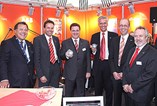Trend Toward Offshore Wind Farms Is Good News For Suppliers Like ABB

Germany, Europe’s biggest producer of wind power, is turning to offshore locations for new wind parks as it seeks to increase electricity production from renewable sources. Suppliers with the necessary technology are set to benefit from this trend, as ABB demonstrated by winning an order worth more than $400 million from E.ON.
The German transmission system operator (TSO) awarded the contract for ABB technology to connect a new wind farm in the North Sea to the German grid. ABB is supplying and installing converter stations and cable using its HVDC Light (high-voltage direct current) transmission technology, which gives TSOs complete control over the power supply and increases grid stability.
The technology is essential to the viability of large offshore wind parks because coastal areas where the power comes to shore are typically sparsely populated and therefore the weakest part of a country’s electricity grid. The Borkum-2 wind park cluster, located more than 100 kilometers off the coast, is set to be the world’s largest and most remote when it starts operating in 2009.
The E.ON order comprises turnkey delivery of an HVDC Light system with a capacity of 400 megawatts (MW), 128 kilometers of sea cables and 75 kilometers of land cables.
Largest T&D order in German history
"It is the single largest order ever made for power transmission and distribution in Germany," said Dr. Joachim Schneider, board member of ABB Germany, speaking at a press conference at HusumWind, an international wind power exhibition in Husum, Germany.
ABB is presenting a portfolio of wind power solutions for grid connections, as well as generators, converters, SCADA systems, transformers, substations and cables at the Husum exhibition, the oldest and largest trade fair for wind energy in the world.
Dr. Urban Keussen, member of the executive board of E.ON Netz responsible for technologies, also hosted the press conference and said Borkum-2 is the first project to feature such a large-scale transfer of wind-generated power from sea to land.
Building a renewable power supply
Germany aims to generate 20 percent of its power from renewable sources by 2020, compared with 12 percent in 2006. Wind power accounted for about 40 percent of Germany’s electricity from renewable sources last year, but with the best onshore locations already developed, the country’s utilities are turning to offshore sites.
The main attraction of going offshore is the enormous wind resource available. Average wind speeds can be 20 percent higher, and the resulting energy yield up to 70 percent greater than on land, according to the environmental organization, Greenpeace. The lack of obstacles such as hills, and the generally smooth surface of the sea, also makes the wind more reliable.
E.ON and ABB announced a huge new offshore wind farm in the North Sea off the coast of Germany. ABB will supply and install converter stations and cable (cross-sections are pictured here) using HVDC Light (high-voltage direct current) transmission technology for complete control over the power supply and increased grid stability.
Offshore parks occupy areas that can’t be used for other developments, unlike land-based parks, and can neither be seen nor heard. However, installation of these systems is costly, especially in the areas far offshore where those advantages come fully into their own.
ABB power transmission specialist, Lars Stendius, said most of Europe's installed wind generation capacity is currently land based, supplying just 3 percent of the continent’s electricity requirements. "If it were better placed offshore, you could satisfy double the consumption - six percent - with what is currently installed," he said.
Wind power's future is offshore
“One of the challenges of offshore wind generation installations is the problem of transporting power that is generated far from the consumers who will actually use it,” said Gunnar Asplund, ABB’s research manager for high-voltage direct current (HVDC).
With more and larger wind parks set to be built offshore, major investments are needed to strengthen the network, deliver more power and find ways to feed the power into the grid. The alternating current technology used in the first, smaller offshore wind parks is increasingly reaching its limits on account of the high reactive power demand of the cables.
HVDC Light, developed by ABB in the 1990s, meets all of these requirements. Since the first installation in 1997, a large number of systems using this technology have been delivered, the most recent being the link between Estonia and Finland (Estlink) which was inaugurated in December 2006.
ABB is the only supplier with this level of experience. The applications of HVDC Light to date extend from marine and terrestrial cable links though power supply to major urban areas and supply for island grids and offshore gas rigs.
When completed, Borkum-2 will have a capacity of 1,500 megawatts, which makes it the highest capacity wind park ever planned, as well the first to use the HVDC technology (high-voltage direct current) to connect the wind park with the grid.
SOURCE: ABB Measurement & Analytics
